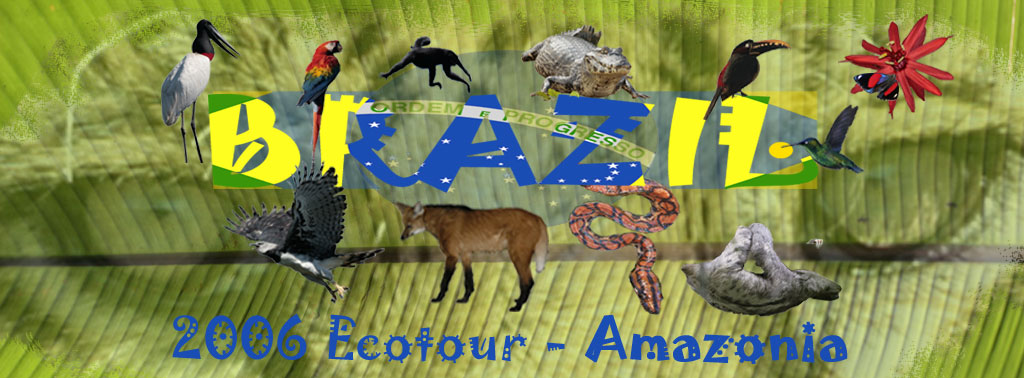



Added 3 September 2006
Day 15: Tuesday, June 20, 2006
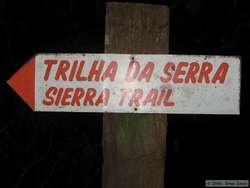 After breakfast, we boarded a boat again and Sabastian took us for a short ride to the start of the Sierra Trail. We towed a canoe and an inflatable kayak upstream for us to float back to the lodge in. Our main objective was to find a yellow and black poison dart frog. Unfortunately, we had two strikes against us before we even started.
After breakfast, we boarded a boat again and Sabastian took us for a short ride to the start of the Sierra Trail. We towed a canoe and an inflatable kayak upstream for us to float back to the lodge in. Our main objective was to find a yellow and black poison dart frog. Unfortunately, we had two strikes against us before we even started. 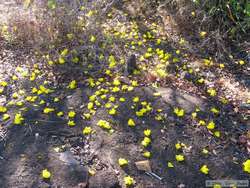 One was the lack of rain so the frogs weren't out, and the other was the fact that there were two plants with bright yellow flowers this time of year, most of which littered the ground. With so many small bright yellow objects on the ground, we could have looked right at many yellow poison dart frogs and not known it.
One was the lack of rain so the frogs weren't out, and the other was the fact that there were two plants with bright yellow flowers this time of year, most of which littered the ground. With so many small bright yellow objects on the ground, we could have looked right at many yellow poison dart frogs and not known it.
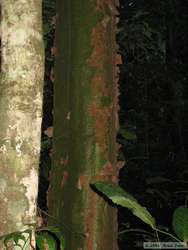 Sabastian hiked with us on the Sierra Trail, and with Fabricio translating, talked about some of the plants we were seeing and what they were used for. One unassuming plant called a murandi (sp?) is still used in dentistry as a local anesthetic. Both Shannon and I chewed on the base of a murandi leaf, and it wasn't long before the numbing effect occurred.
Sabastian hiked with us on the Sierra Trail, and with Fabricio translating, talked about some of the plants we were seeing and what they were used for. One unassuming plant called a murandi (sp?) is still used in dentistry as a local anesthetic. Both Shannon and I chewed on the base of a murandi leaf, and it wasn't long before the numbing effect occurred. 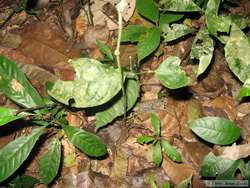 Apparently the root is even more potent. Sabastian also pointed out that the pashuba (sp?) tree, which I had been calling the "grass skirt tree" because it has a bunch of roots or buttresses fanning out at the base of the tree like a skirt, is used by the Indians for furniture, and that they also eat the sap. Another interesting fact was about the palmalato (sp?) tree, which has a "skin" that one often sees peeling off. The skin of the tree can be used like a band-aid, and apparently has properties that help wounds heal faster.
Apparently the root is even more potent. Sabastian also pointed out that the pashuba (sp?) tree, which I had been calling the "grass skirt tree" because it has a bunch of roots or buttresses fanning out at the base of the tree like a skirt, is used by the Indians for furniture, and that they also eat the sap. Another interesting fact was about the palmalato (sp?) tree, which has a "skin" that one often sees peeling off. The skin of the tree can be used like a band-aid, and apparently has properties that help wounds heal faster.
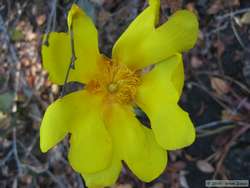
|
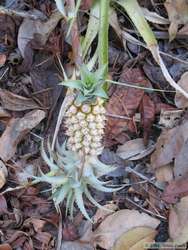
|
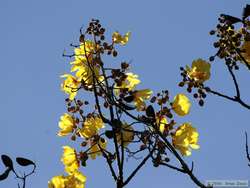
|
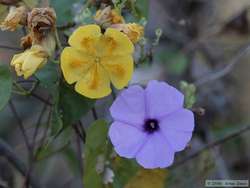
|
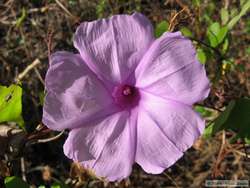
|
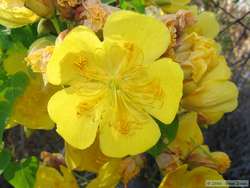
|

|
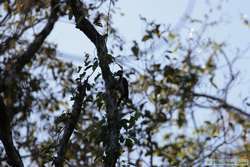
|
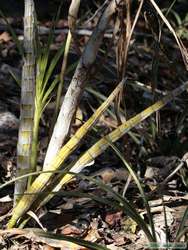
|
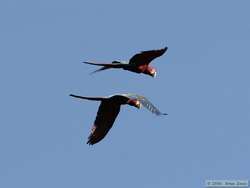
|
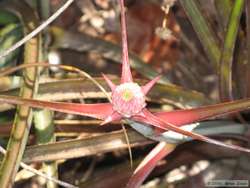
|

|
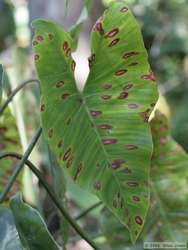
|
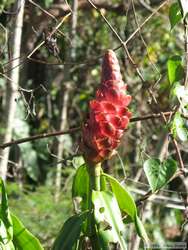
|
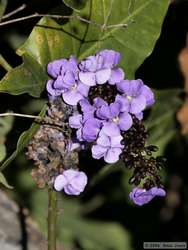
|
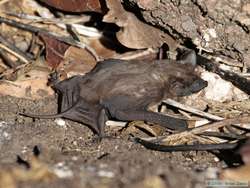 The trail climbs pretty steeply up a ridge line where there is a lot of exposed rock, which is somewhat unusual in and of itself from what I had seen. We continued climbing while searching for the poison dart frogs, Sabastian turned over a rock and instead of a frog, found a bat. It was a really large rock, so I was concerned about him putting the rock back down on top of the bat since it had moved. Shan and I tried to tell him to just leave the rock overturned and let the bat crawl back under it or move to a new location, but he didn't understand what we were saying and put it back.
The trail climbs pretty steeply up a ridge line where there is a lot of exposed rock, which is somewhat unusual in and of itself from what I had seen. We continued climbing while searching for the poison dart frogs, Sabastian turned over a rock and instead of a frog, found a bat. It was a really large rock, so I was concerned about him putting the rock back down on top of the bat since it had moved. Shan and I tried to tell him to just leave the rock overturned and let the bat crawl back under it or move to a new location, but he didn't understand what we were saying and put it back. 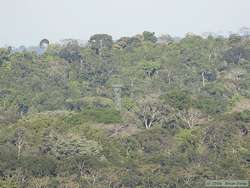 Before we left, I checked under the rock and made sure the bat was alive, which it was. I couldn't tell if it was injured though. I really hope it was, and I feel horrible at even the possibility that it might have been injured.
Before we left, I checked under the rock and made sure the bat was alive, which it was. I couldn't tell if it was injured though. I really hope it was, and I feel horrible at even the possibility that it might have been injured.
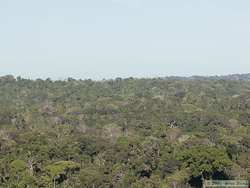 After leaving the bat, we continued our ascent and ended up at a lookout, from which it was possible to see a large expanse of the preserve, a tiny bit of the river, and way off in the distance, the 50 meter tower. Near the lookout we saw a hummingbird nest with babies in it, and a black vulture (Coragyps atratus) nest, with a fledgling at it.
After leaving the bat, we continued our ascent and ended up at a lookout, from which it was possible to see a large expanse of the preserve, a tiny bit of the river, and way off in the distance, the 50 meter tower. Near the lookout we saw a hummingbird nest with babies in it, and a black vulture (Coragyps atratus) nest, with a fledgling at it.
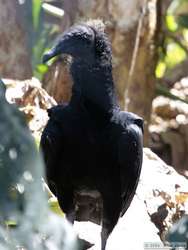
|
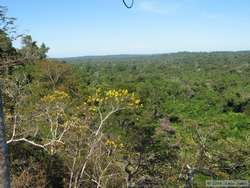
|
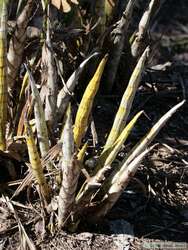
|
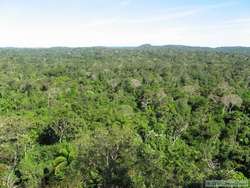
|
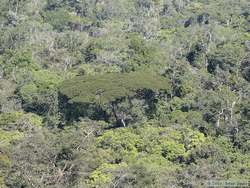
|
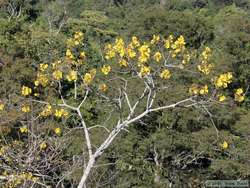
|
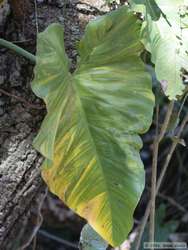
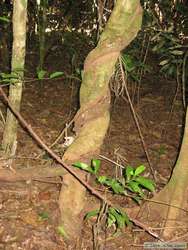 We didn't stop much on the way back to the river, and once there, Shan and I got in the canoe and Fabricio took the inflatable kayak while Sabastian shadowed us in the boat, usually just floating, but occasionally using the motor.
We didn't stop much on the way back to the river, and once there, Shan and I got in the canoe and Fabricio took the inflatable kayak while Sabastian shadowed us in the boat, usually just floating, but occasionally using the motor. 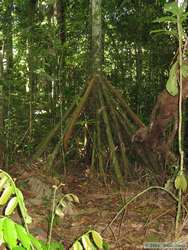 Apparently he had to stick close to us for safety reasons. When we got closer to the lodge, he motored on in, leaving only the sounds of our paddles and the birds.
Apparently he had to stick close to us for safety reasons. When we got closer to the lodge, he motored on in, leaving only the sounds of our paddles and the birds.
At one point, we passed by the film crew on the bank of the river, and I'm pretty sure they were filming us as we paddled by. I figured if they were, they wouldn't want us looking at the camera, so I didn't look over to verify, but the camera was definitely pointed at us when I first saw them. I think we made a good show of it for them though.
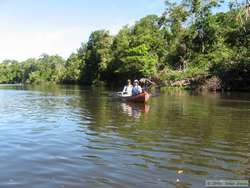
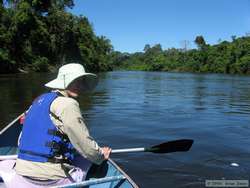 Since we were in a canoe using kayak paddles (really short kayak paddles no less), we weren't as maneuverable as I would have liked. It also meant that we couldn't put much power to the water, so paddling upstream, which would have been pretty easy otherwise, wasn't much of an option. So the trip back to the lodge wasn't as nice as I had envisioned beforehand. By that point, it was late in the morning as well, so there wasn't much to see. I would have loved to have had my kayak there.
Since we were in a canoe using kayak paddles (really short kayak paddles no less), we weren't as maneuverable as I would have liked. It also meant that we couldn't put much power to the water, so paddling upstream, which would have been pretty easy otherwise, wasn't much of an option. So the trip back to the lodge wasn't as nice as I had envisioned beforehand. By that point, it was late in the morning as well, so there wasn't much to see. I would have loved to have had my kayak there.
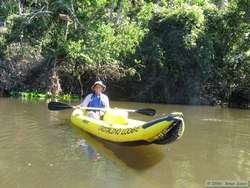
|
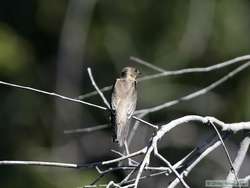
|
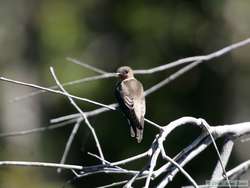
|
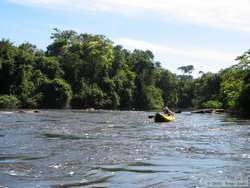
|
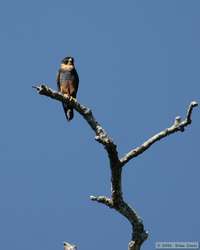
|

|
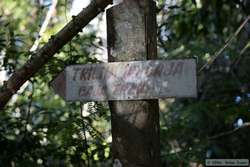
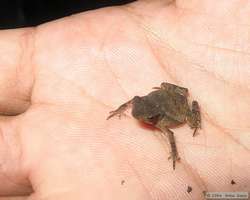 In the afternoon, we hiked the Caja Trail, which follows the river downstream for a ways before heading over to the Tower Trail. Along the Caja Trail we got a great look at some black caracara (Daptrius ater). Fabricio was also really good at finding a couple of really small frogs along the trail.
In the afternoon, we hiked the Caja Trail, which follows the river downstream for a ways before heading over to the Tower Trail. Along the Caja Trail we got a great look at some black caracara (Daptrius ater). Fabricio was also really good at finding a couple of really small frogs along the trail.
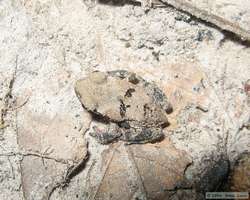
|

|
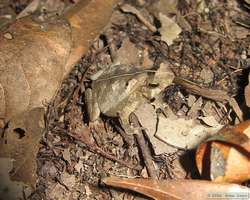
|
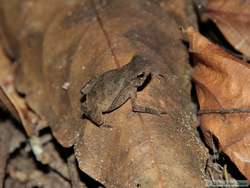
|
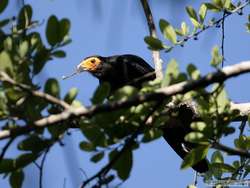
|
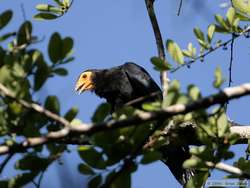
|
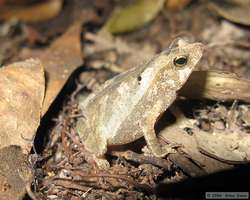
|
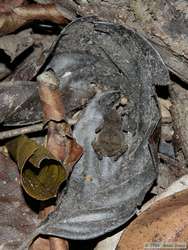
|
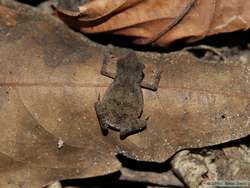
|
According to Fabricio, the spiked buttress-like root at left below is used by tribal peoples as a method of punishment. It is used to scrape an offenders back-side. Ouch!
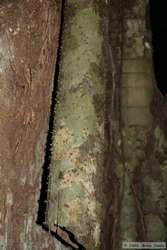
|
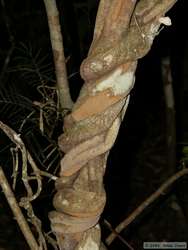
|
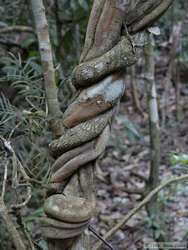
|
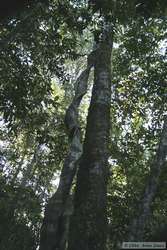
|
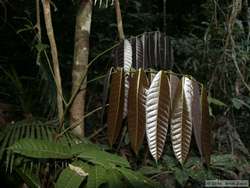
|
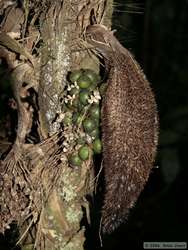
|
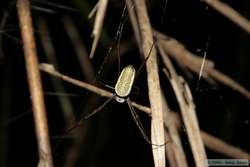
|
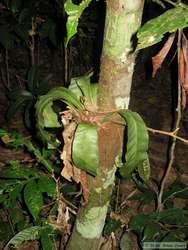
|
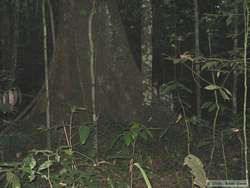
|
After dinner, we watched some slide shows that Wil and Jill had put together for birds, butterflies, and herps that have been found at Rio Cristalino. I recognized much of what was in the slideshows, but there were a lot of things we hadn't seen as well. After the slideshows, I went down to the boat dock briefly to see if there were any new frogs or toads, but there weren't. I did get some pictrures of some fish and some insects though. And on the way back to the bungalow I was able to get some pictures of some bats in flight.
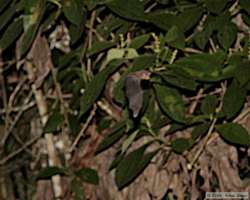
|
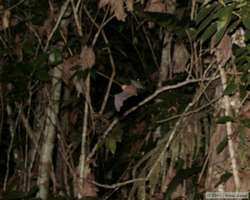
|
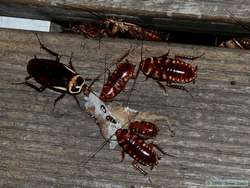
|

|

|
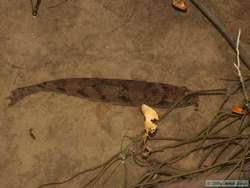
|
Earlier in the day, Fabricio let us know that our request was granted, and we could shorten our stay at Rio Cristalino by one night in exchange for one more night at Floresta Amazonica Hotel. 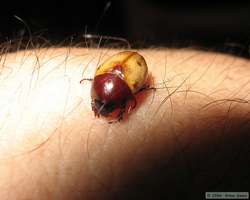
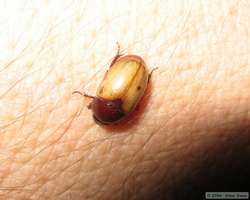 That made this night my last at the jungle lodge. Since there wasn't much excitement down at the dock, I wanted to do something else to make the most of my final night there. I went back to the room and let Shan know I was going to go on a short night hike. She was not at all happy about the news, as she is a worry-wort and thought I was going to die. To put her at ease somewhat, I promised I'd return by a certain time, which was far sooner than I would have liked to have returned, but oh well. On my night hike I saw a blackish nightjar (Caprimulgus nigrescens) (I think) and some cool insects.
That made this night my last at the jungle lodge. Since there wasn't much excitement down at the dock, I wanted to do something else to make the most of my final night there. I went back to the room and let Shan know I was going to go on a short night hike. She was not at all happy about the news, as she is a worry-wort and thought I was going to die. To put her at ease somewhat, I promised I'd return by a certain time, which was far sooner than I would have liked to have returned, but oh well. On my night hike I saw a blackish nightjar (Caprimulgus nigrescens) (I think) and some cool insects.
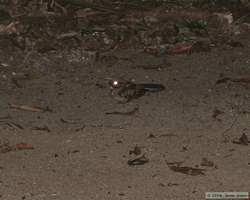
|
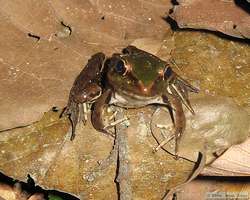
|
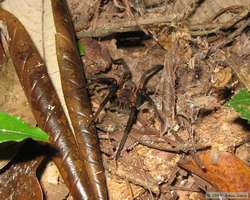
|

|
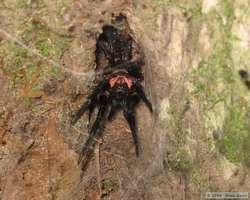
|
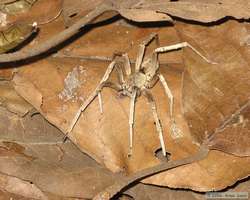
|
Species list for the day (25 birds, 1 mammal, 1 reptile, 3 amphibians):
Anhinga (Anhinga anhinga)
Capped Heron (Pilherodius pileatus)
Bat Falcon (Falco rufigularis)
Black Vulture (Coragyps atratus)
King Vulture (Sarcoramphus papa)
Crane Hawk (Geranospiza caerulescens)
Black Caracara (Daptrius ater)
Gray-fronted Dove (Leptotila rufaxilla)
Scarlet Macaw (Ara macao)
Blue-headed Parrot (Pionus menstruus)
Blackish Nightjar (Caprimulgus nigrescens)
White-necked Jacobin (Florisuga mellivora)
Amazon Kingfisher (Chloroceryle amazona)
Black-fronted Nunbird (Monasa nigrifrons)
Lineated Woodpecker (Dryocopus lineatus)
Strong-billed Wdcrpr. (Xiphocolaptes promeropirhynchus)
Buff-throated Woodcreeper (Xiphorhynchus guttatus)
Screaming Piha (Lipaugus vociferans)
Red-headed Manakin (Pipra rubrocapilla)
White-winged Swallow (Tachycineta albiventer)
White-banded Swallow (Atticora fasciata)
Southern Rough-winged Swallow (Stelgidopteryx ruficollis)
Palm Tanager (Thraupis palmarum)
Yellow-rumped Cacique (Cacicus cela)
Red-breasted Blackbird (Leistes militaris)
White-whiskered Spider Monkey (Ateles marginatus)
Amazon Racerunner aka Green Ameiva (Ameiva ameiva)
Amazon River Frog (Rana palmipes)
Smooth Sided Toad (Bufo guttatus)
South American common Toad (Bufo margaritifer)
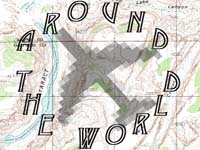 |
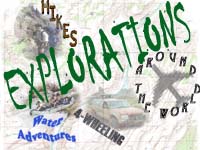 |